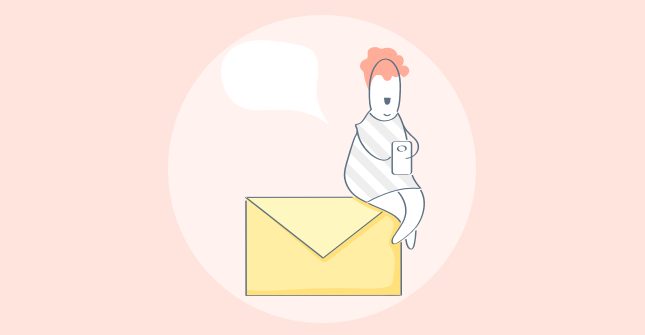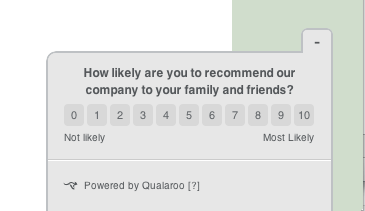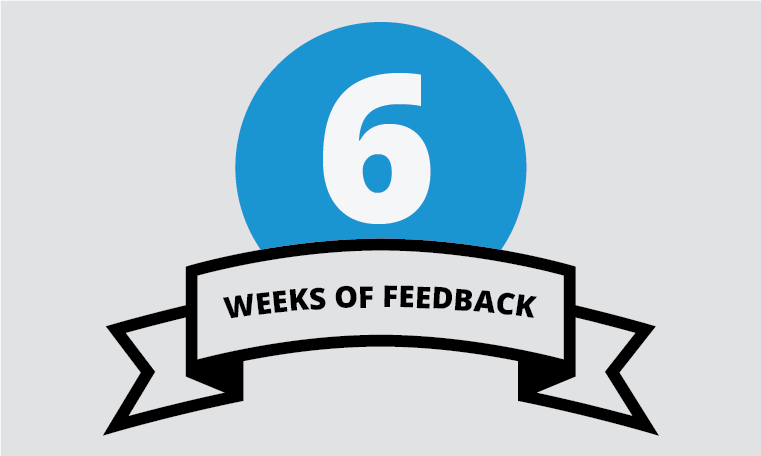Before we discuss customer intent, let’s put forward a familiar scenario:
Have you ever started your search to buy a product (say smartphone, laptop, or electronic product) with a brand in mind but ended up buying it from a different company?
Why did it happen?
Because the brand you picked fit your needs and desires and thus, appealed to your purchase intent. It could be affordable pricing, better features, better support, or an extended warranty.
But what is customer intent?
It’s defined as the purpose or goal behind a customer’s purchase decision or conversion. And if you can convince them that the path to reach that goal is through you, your product would be their destination.
And when it comes to SEO, understanding customer intent is Google’s number #1 priority.
Why?
Because among millions of pages present on the internet, the search engine wants to show only those pages that fulfill the context of an entered query.
And who doesn’t want their webpage in the first result?
So, customer intent is key to bringing more customers and revenue to your website.
And that’s what we have in store for you today. We’ll explore types of customer intent in detail and their importance in your business. We’ll also list a few ways to capture user intent and use it to design your marketing strategies.
Let’s get this show on the road.
What is Customer Intent & What are its Types?
Customer intent, also called buyer intent, user intent, or purchase intent, is defined as the motivation or thought that makes a person start the buyer’s journey. For example, if someone wants to buy shoes, they would start by going to their favorite shoe store and trying different pairs. Or, they may start by Googling something like ‘latest Adidas shoes for men.’
As a starting point of every customer journey, it’s the kind of information the user is looking for when typing a search term into Google and other search engines.
- If they are trying to find information about a product or topic, they would want to land on a detailed blog.
- If it is a solution they are looking for, like how to troubleshoot your desktop, they will probably click on the product guide or a Youtube tutorial video.
- In the same way, to buy a product like a laptop, e-commerce websites such as Amazon would be the ideal destination.
Say a person wants to buy a pair of shoes. So, they enter a related term into the search engine and click on different e-commerce sites in the results until they find what they are looking for. When satisfied with a page, they interact with its CTA and move to the next conversion step.
On the other hand, no one wants to find links to e-commerce sites selling computers in their search results when trying to find a solution to fix their desktop.
Imagine you have loads of work and your computer freezes. Now you are on your mobile trying to find a relevant page on Google to help you troubleshoot, but it keeps spitting random results.
Pretty frustrating situation. Isn’t it?
You can now see why user intent analysis is crucial.
That’s why Google also stresses it, as evident by its Quality Raters Guidelines document.
And Google’s BERT (Bidirectional Encoder Representations from Transformers) algorithm update in 2019 also aims to improve the understanding of the context behind the search query to give users what they are looking for.
The search engines want to show the best result, so people don’t pogo-stick on the Search Engine Results Pages (SERPs).
Plus, connecting with a visitor’s intent is one of the most effective ways to keep them engaged during the conversion process. While they are engaged, you can steer them toward a gratifying experience with your solution.
But before we talk about understanding the context, let’s understand different types of customer intents with examples:
1. Informational Customer Intent
Informational intent is when people are trying to educate themselves about a topic.
For example, we wrote this blog keeping informational intent in mind. It means we aim to give a broad yet detailed idea about buyer intent and how you can make the most out of it for your business by understanding it.
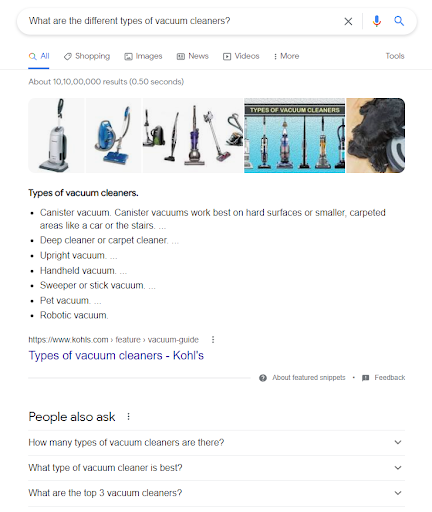
Informational search queries usually include interrogative phrases like ‘how to,’ ‘what is,’ ‘who is, ‘why do,’ ‘where is,’ and others.
Here are some informational intent examples:
- What are the different types of vacuum cleaners?
- How to resolve the blue screen error in Windows 10?
- Who is the author of Harry Potter?
- In which sequence should I watch Star Wars movies?
- What is conversion rate optimization?
- How to optimize your website?
Why should you care about it?
People with informational intent are placed at the top of the conversion funnel. They are just starting their buyer’s journey for a product by knowing more about the topic.
For example, a person who has never bought a vacuum cleaner would start by searching the following: what are the different types of vacuum cleaners?
So by creating high-quality content around such queries, you can bring more traffic to your website and advance them into the sales funnel using lead forms and other lead magnets.
2. Navigational Customer Intent
Navigational intent carries more specific queries because people are trying to find a specific site or web page.
For example, typing ‘Qualaroo NPS‘ on Google shows Qualaroo’s dedicated landing page on the NPS survey as the first result. It means people want to see a detailed page on how the NPS survey works in Qualaroo’s survey tool. So they click on that page first, and ergo it ranks higher.

Here are some navigational intent examples:
- JP Morgan login
- WHO
- Ducati bikes
- Beginners guide to SEO Moz
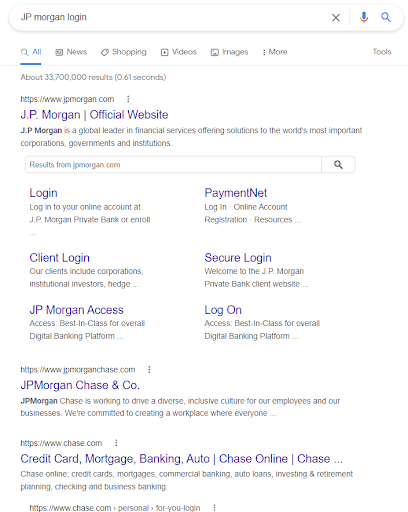
Though this type of query indicates people at the middle of the funnel, it is hard to target as there is usually a brand associated with the search term and includes branded keywords.
So, unless you are the target brand in the search query, you cannot expect much returns on your investments.
3. Transactional Customer Intent
Transactional intent is when a person is at the end of the conversion funnel and wants to complete an action. It can be making a purchase, signing up for an email, scheduling a demo, or visiting a store.
It means that person knows what they want and moves towards conversions. It is the final step before converting the prospect into a customer.
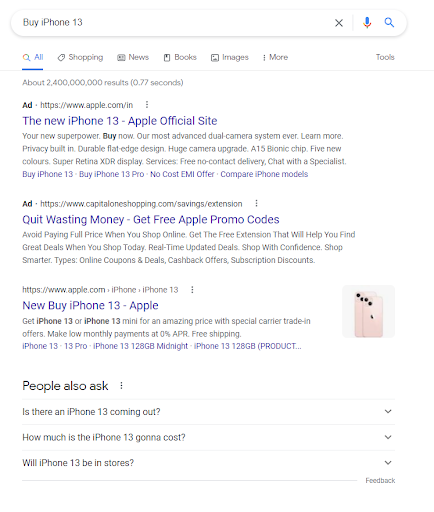
Here are transactional intent examples:
- Buy Adidas shoes
- Amazon Black Friday coupon
- Pay Verizon bill
- Buy iPhone 13
- Buy laptop below 50k
- Book Spider-Man movie ticket
If a search term results in a Google snippet with product carousels from different sites, it means that keyword carries a transactional intent.
So, you can create organic content and optimize it with local SEO strategies to target these search queries. Another way to maximize your brand’s visibility is by investing in paid search to target this intent type.
Importance of Customer Intent
From content creation and ranking better on the SERPs to designing hyper-targeted ads, here are some areas where capturing user intent can help you maximize the returns on your efforts:
1. Improve SEO & Website Visibility
Search engines have evolved with time by understanding what users want when they type a search term into the browser. It’s not just about adding top-ranking keywords into your content anymore.
Google also looks for the queries’ context, semantic meaning, and user intent to provide the best results to the users. It associates searches and keywords with what people want to see.
Why is user intent important for SEO?
Search intent has been cited as a top-ranking factor by the world’s most celebrated SEO experts as well.
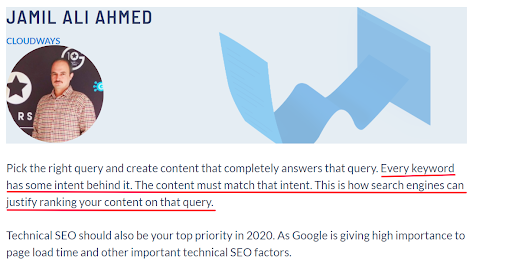
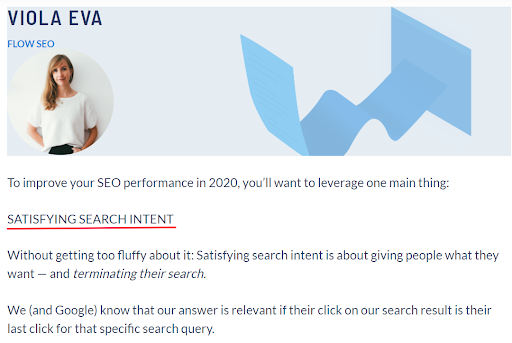
Remember the entire heading dedicated to user intent in Google’s Quality rater Guidelines?
That’s how important is user intent for getting an edge in SEO in 2022. It needs to be the central cog in your SEO and marketing strategies to improve the website’s ranking and visibility.
2. Create & Deliver Actionable Content
Each search term or keyword refers to specific information people are looking for.
For example:
- Some keywords reflect visitors looking for information around a subject or problem (Informational intent).
- Others reflect people in the middle of the conversion funnel who know about the solution and are trying to find how to implement it (Navigational intent).
- Another set of keywords reflects prospects at the end of the funnel looking for the best tool/company to make a purchase (Transactional intent).
Want to see how it works?
Here is the Google search result for ‘survey tool’:
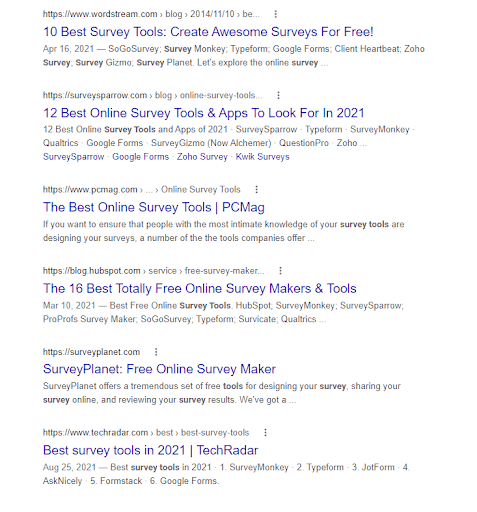
We can see that almost all the results for this term focus on listicles about the best survey tools in the market.
But why is that?
Yes, you guessed it right – customer intent.
Most people want to see a list of tools around this term. So, if you create a blog for this keyword, it may get stuck on the 2nd or 3rd page.
But if we now change the query to – ‘survey tool free,’ most results are individual survey tool websites. It means the intent has changed from informational to transactional.
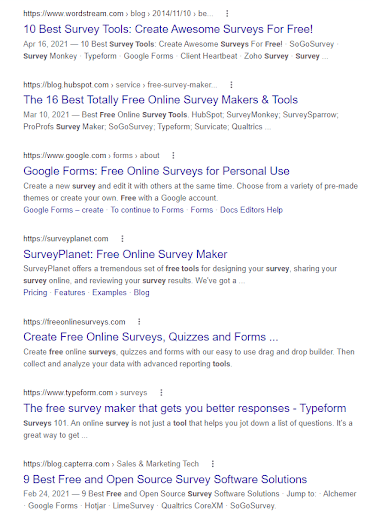
In a nutshell, apart from traditional ranking like backlinks and high-quality content (E.A.T.), Google’s algorithm tracks intent signals to understand the customer intent behind each query and deliver what the customer wants to see in the search results.
And you can take advantage of this too.
By using competition analysis and in-depth keyword research, you can find out what kind of keywords to target in your content. It will also inform you what kind of content your visitors expect when they click on a result for a specific term.
That’s what we did before creating this piece, and here you are. We hope we measured up to your intent. 🙂
And when your content matches the visitor’s intentions, you can achieve better engagement, higher SEO, and more website traffic.
It also affects other performance metrics like bounce rate, the click-through rate on the CTA, time on page, and conversion rate.
Related Read: 25 Best Online Survey Software
3. Design Better Ads & Marketing Strategies
Like the content, people also respond to ads that tie the USP to what they are looking for.
That’s what intent-based marketing is.
It helps to target the position of a prospect in the conversion funnel. By studying what people want to see for different keywords, you can design your marketing strategies to show intent-based ads.
Once they click on the ad and land on your webpage, drive engagement with high-quality content to increase lead generation.
See how it all ties together for your ads and page content?
That’s why customer intent analysis needs to be at the heart of your page content and ads strategy.
Here’s an example to further this point. Here’s an old Google ad from Blue cross insurance:
What do you wish to see when you click on this ad?
The most common answer would be to read more about the company’s policies and plans.
But this is what you get.
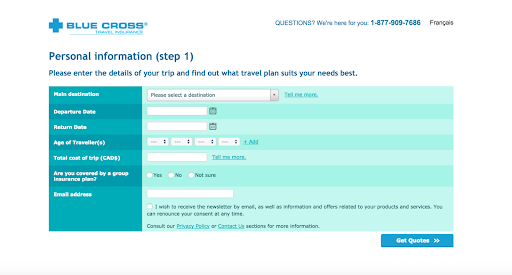
A landing page with a lead form that asks for personal information without details about the process or the company’s value proposition.
If you were one of the prospects, what are the chances of signing up for a Quote?
None, nada, zero, zilch.
That’s why it’s necessary to align your page and the ad with the customer intent to create a seamless experience for the prospects and promote conversions.
And the same goes for other marketing channels. With customer intent modeling, you can combine various audience data sources to understand your target market’s behavior, mindset, needs, problems, and desires.
How will this help you?
It will help you speak directly to your target audience using personalized value propositions and call-to-actions to address their problems and desires.
Whether it’s personalized notifications or headlines of your email campaign, if you know what makes them tick or click), you have nailed the customer intent.
And it all leads to highly targeted ads, more leads, and more conversions.
4. Optimize Your Website
Tell me does the following sound familiar?
You have high-quality content on your webpage, and it is performing well on the SERPs. But after some time, you noticed a drop in SEO ranking and traffic.
There can be several reasons for that result, such as your competition outranking you with a better SEO campaign (we are sorry if that’s the case), or there might be some technical issue with the webpage.
But there is one more possibility, which sits equally among other factors – The customer intent has changed around your target keywords.
And when that happens, Google modifies the results based on trending user intent and sidelines your champion content in the process.
But don’t worry. You can easily fix it with intent-based optimization.
As explained in the next section, you can head over to the websites that took away your position in the SERPs, analyze their content (competition analysis), and optimize your page for the right customer intent.
And if done correctly, you will regain what was once yours.
Related Read: How To Optimize Your Website & Improve Conversion Rates
5. Improve Product Recommendations
Product recommendations and suggestions only work when you tailor them to suit people’s most recent behavior and actions.
For example:
- If a customer is about to place an order for a smartphone, they may also be interested in a protective cover and ear pods. So, you show these as product suggestions at a lower price during checkout.
- If a visitor has viewed your product twice in one day, you know they want to purchase it, but something is holding them back. So, add a small gated survey with a lead form to target repeat visitors to collect their email addresses, offer them a discount and then retarget them with a personalized email.
- If someone left a product in their cart but didn’t place the order, send them a personalized offer via SMS notification, email, in-app notification, etc.
That’s what real-time intent targeting is. It helps to predict what customers want and approach them at the precise moment with suitable means to pull them towards conversion.
And the best part is you can employ AI-based engines, such as IBM Watson, to automatically track on-site (first-hand data) and off-site (second-hand data) actions to identify what visitors are interested in on your website and outside it.
Not only that, these engines can match the behavioral history of other similar customers to predict the intent of the current visitor and recommend the right products.
How Customer Intent is Beneficial for SaaS Business
Unlike casual shoppers or website users, SaaS clients look for particular requirements before starting a subscription service with you.
It means you need to study the stage of visitor awareness to determine what a particular user type is looking for.
That’s where user intent comes into play.
A typical Saas prospect lies between transaction and research intent. And your job is to nail it perfectly to reel the customer into your sales funnel.
Here’s what your SaaS prospects look like, and you can use the awareness to understand customer’s intent and target them with relevant strategies:
1. TOFU (Top of the Funnel) Prospects
This stage is the start of the buyer’s journey. Naturally, they would start by researching the product type and its functionality, say a feedback tool. In this case, the first search term would likely be – ‘How does customer feedback tool work?’
Here we can see that intent is informational. A person may be trying to develop a feedback model for their business. So, they want to understand the concept before moving further.
To target this, you can create TOFU (top of the funnel) content like a general article or a video describing a survey tool’s basic features.
2. MOFU (Middle of the Funnel) Prospects
Here the search term is – ‘Best NPS tools.’
The customer intent here is more specific. It has transitioned from information to the exploration or clarification phase.
It’s a MOFU (middle of the funnel) prospect. They may be looking for a tool to design and analyze NPS surveys. A general blog on surveys may be too broad for such a prospect as it may act as a distraction.
To target this type of customer purchase intent, you can design a solution landing page dedicated to the NPS survey and also show how you have the best NPS tool in the market.
In the same way, you can create a video around NPS surveys as we have on our channel.
That’s why we see brands adding specific solutions or use case sections targeting MOFU content.
3. The Comparison Stage (STILL MOFU)
The most probable search term – ‘Qualaroo vs. SurveyMonkey.’
The prospect has gone through multiple software brands and fixed their gaze over two or three tools. By this point, they know you exist.
You are up against the top two or three competitors.
At this stage, case studies, testimonials, reviews, and other credible sources can be your best bet to make you a favorable choice.
Here’s how:
- Add testimonials on the home page and other web pages. You can also showcase any rewards or recognitions.
- Add case studies and reviews on the product pages.
- Design long-form landing pages that specifically target prospects’ purchase intent near the end of the conversion funnel.
- Include the pricing details and product images.
- To make the most out of it, add lead magnets and lead forms to such pages to collect contact information and nurture your leads.
4. The BOFU (Bottom of the Funnel) Stage
When prospects reach the BOFU (bottom of the funnel) stage, they are at the cusp of purchasing and need a little nudge.
That’s where better offers and services like discounts, custom subscription plans, free product demos, and more can come in handy.
Here’s how you can target such SaaS prospects:
- Use email campaigns to show why you are the best choice for them.
- Do pricing analysis to make sure your pricing structure appeals to different people with different purchase intent & preferences.
Why Are We Telling You All This?
Because gaining a good grasp of users’ intent can help your SaaS business in different ways, namely:
- Design personalized marketing campaigns
- Create effective landing pages
- Add the correct information & product offering to the website pages to increase engagement.
- Entertain different customer types with unique value propositions to improve conversion rates.
- Acquire the right customers to reduce overall acquisition cost and churn rate.
- Collect data for retargeting and activating churned customers.
How to Understand & Capture Customer Intent?
Now that we know the importance of customer intent analysis in your business, the obvious question in anyone’s mind would be – How do I tie down that bull?
And the most important of them all – Will it burn a hole in my pocket?
Well, that depends. You can start with as little as a few dollars using a feedback tool and SEO tool. Or, you can go all the way with an advanced AI-based intent tool, depending on your budget and scope of implementation.
Let’s jot down some of the ways to capture the user intent, and you can pick the ones that are feasible to deploy at your end:
Use Customer Feedback Tools
The simplest way to understand customer intent is to ask them directly.
Remember we asked you what your intent was when you clicked on this blog. You can do it with your website visitors with the help of surveys and feedback forms.
But how?
User feedback has a two-pronged effect:
- It is one of the best ways to learn about what your target audience is looking for on your website. It gives you an idea of what people expect when they land on your web page so you can design it accordingly.
- It also helps you gauge whether the target keywords are bringing the right audience to your website or not. You can optimize the website page for top keywords to bring considerable traffic, but people will not convert if the content does not match the user intent.
Just find a suitable tool like Qualaroo, implement a quick survey and ask the following question – What is it you came to do on this site today?
Here’s how you can use customer feedback to uncover search intent:
- Implement a non-intrusive simple pulse survey to find out if the visitors could find what they are looking for.
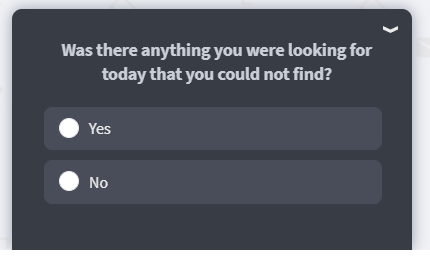
- Target different audiences based on their actions and behavior like exit intent, first-time visitors, location, device, and repeat visitors to collect data points from different customer segments.

- Add follow-up survey questions to the survey to discover their issues and pain points. With this, you can design specific content, landing pages, ads, and email campaigns with personalized value propositions to improve CTR.
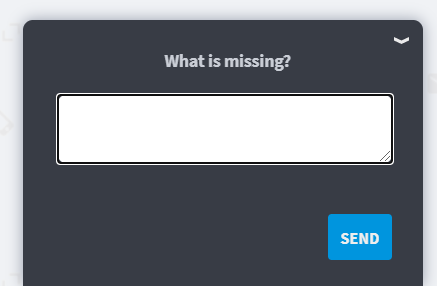
You can then channel this feedback into your SEO & content strategy to reduce bounce rate, increase average page time, improve content relevancy, and increase conversions.
Related Read: Best Customer Feedback Software in 2022
2. Use Quiz & Lead Pop-Ups Along the Customer’s Journey
Another practical way to predict customer intent is to ask for visitors’ contact information.
No, we are not pulling things out of thin air. Hear us out.
A prospect who lands on your web page and is willing to give personal information must see something of value in your product. At the very least, these prospects want to explore more about the product and thus carry purchase intent.
But how do you identify this behavior and target it?
Pop-ups!!!
Like surveys, pop-ups can help understand customer intent and much more.
For example,
- You can create a quiz to gauge how likely a prospect is ready to purchase and redirect them to the relevant page.
- Use a pop-up tool like Picreel to show a lead pop-up when visitors hover over the CTA or reach a particular section on the page, such as features. If they fill out the form, you can begin the next phase to convert them.
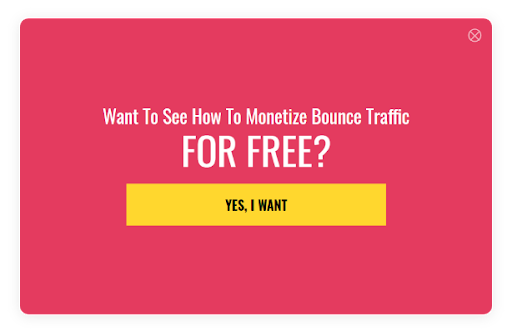
- Throw in freebies and intent-based lead magnets to further increase chances of conversion like a free demo, free consultation, etc.
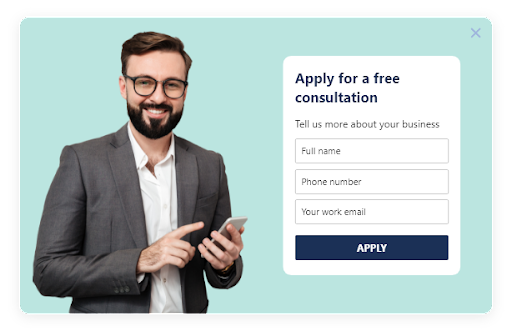
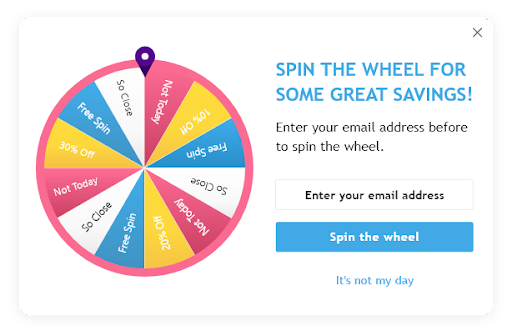
There is just one caveat. Ensure that the pop-ups overlays don’t impede user experience, or this strategy could backfire.
Instead of collecting user intent data & generating new leads, you can end up losing valuable prospects.
Related Read: 11 Best Exit-Intent Popup Tools to Increase Customer Retention
3. Add a knowledge base to your website and app
Your knowledge base acts as an internal search engine for your visitors. It’s a treasure trove of actual search queries giving you in-depth information about what people want to see on your website.
And more importantly, the knowledge base also attracts people with buyer intent.
Think about it. These scavengers are not on your main web page or homepage but in the bellows of your notes section. They are scouring your help center looking for something specific about your products or services.
And here’s how you can take advantage of a Knowledge Base for customer intent analysis:
- Add a Knowledge Base portal on the website or app. (It’s a given)
- Choose the one that stores the searched queries in the background and provides an in-depth analytics dashboard.
- It will help you track Knowledge base performance and uncover actual search queries from what people enter into the search bar.
- Then, cross-reference your target keywords with the most popular search queries to design help articles, blogs, how-to guides, and other content pieces.
- Create content around those queries to match the user intent.
When you are all set up, here are some benefits that you would find worth the effort:
- It enables intent-based targeting by helping you develop content around the most searched queries to improve customer engagement and time-on-page.
- Knowledge base articles also get indexed by Google, which can help boost your website’s SEO and website traffic.
- Use CTAs on the Knowledge Base pages to push visitors along the conversion funnel using relevant lead magnets. These include free product demos and limited-time access to premium or discount offers.
- You can also add lead generation pop-ups, surveys, and other feedback sidebar forms to capture more in-depth insights and new leads to grow your mailing list.
4. Use Clickstream Data & Heatmaps
Do you know why a cooking video works better than a listed recipe? Because it adds more context with step-by-step visual aid.
In the same way, most people prefer to watch Lord of the Rings than read the book because it’s a visual masterpiece.
And that’s also what visualization tools do. They help you visualize customer behavior and uncover their intent with the help of heatmaps, clickstream data, screen recording, gaze plots, and more.
For example, why is the conversion rate low on your landing page when it receives substantial website traffic?
Enter screen recording tools.
These can show you that the CTA is placed at the bottom of the page, and people click on other links before reaching it. Or, when they click on it, the button doesn’t work.
How do these tools work to discover user intent?
- High clicks on the non-clickable area indicate that people expect something to happen on the element. Maybe the color of the element confuses them with a clickable link.
- For example, people clicking on the product images/logos on the page expect to go to the product page. With this data, you can make it a clickable area to help people in the conversion process.
- In the same way, you can find how people interact with the navigation menu and put the most interacted links in the front to maximize interactions.
You can also put the shoe on the other foot and check whether the page meets the user’s intent or not.
Here’s how:
- Use heat maps to gauge how people scroll through the content. For example, suppose you see people scrolling on the page’s content but not clicking on the CTA. It might indicate a disparity between the page content and CTA headline.
- It lets you test the CTA color, image, messaging, and other elements.
- To get more insights on the behavior, you can add surveys to collect visitor feedback.
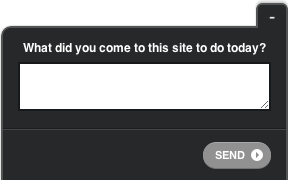
- You can also compare two similar pages using screen recording or clickstream data to view how people interact with them. Observe the page with higher conversions or click-through rates. Then, implement your findings on the other pages to improve engagement.
Tip: The best way to use behavioral tools is to complement them with other data types like surveys and website analytics. It will give you a clear understanding of customers’ behavior and help to pinpoint the actual issue.
5. Run Competition Analysis
If you aim to stay ahead of your competitors on the SERPs, competition analysis is a must. It gives you an understanding of top-performing pages for different topics.
So, if you wish to target people at a specific point on the sales funnel, you can examine what kind of pages other brands are developing to attract such prospects. It will give you an idea about the page format, content, different elements on the page, and type of CTA.
Plus, with tools like Ahrefs, you can do competitors’ keyword analysis.
Here’s a brief overview of how competition analysis can help you hone in on the customer intent:
- To get started, head to SEMrush, Ahrefs, Google Search Console, or any other SEO tool at your disposal and type the terms related to the topic you want to write about.
- Now, find the best-performing pages for these keywords and look at the queries driving the most clicks and impressions. Refer to the top results, LSI keywords, and other semantic phrases.
- It will help you locate other related keywords on the topic and their monthly volume.
You will also learn what Google thinks are the most relevant results for these queries.
Next, dive into the top results to note down details like:
- Page format
- Type of information on the page.
- Word count, subheadings, and other elements.
- Backlinks associated with the page.
Quite a workload. Isn’t it?
But don’t worry, the hard part is over because it’s time to create your page around the target keywords using the findings.
In the same way, if you want to optimize an existing page, you can use competitive analysis to find the gaps between the search intent related to that query and what you are offering on the page.
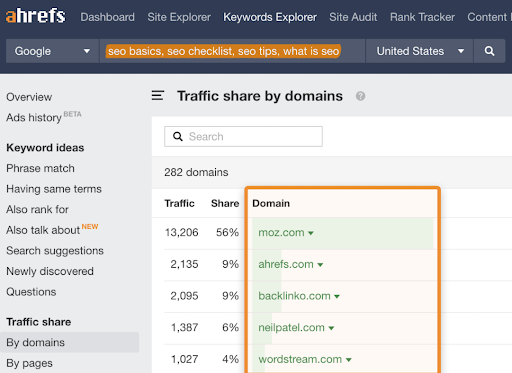
Maybe add a small survey to find out if people find the information helpful and ask for suggestions to optimize it.
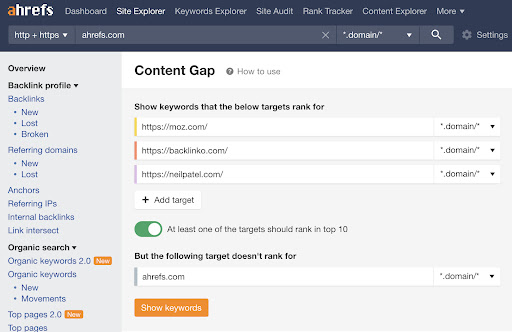
Once done, you can track the performance to see how fruitful your optimization efforts were and repeat the cycle.
Remember, the goal is to increase organic traffic, SEO rankings, and the number of clicks on the CTA. And for that to happen, your web pages need to reflect what visitors want to see.
You can also use advanced SEO tools to reduce the number of steps in the process.
Tip: User intent changes with time, so make sure to redo your research when it’s time to update the content.
6. Use Live Chat & Chatbots
Another way is to understand and act on user intent in real-time is to add a live chat widget on the website or app. It’s good for collecting valuable insights and helping customers simultaneously.
A simple live chat widget on your website or app can be a secondary source of quick information for people who land on your pages.

It’s an excellent opportunity to engage with your visitors in real-time, understand their purpose, map their preferences, and address their issues.
And you don’t need an actual human at the end of each chat interaction.
With AI-based chatbot systems, you can have an automated chat agent to handle the visitors 24×7. These chatbots can manage the conversational flows automatically to provide precise answers. However, for businesses that don’t have the resources to manage this in-house, choosing to outsource call center support can ensure customers still receive 24/7 assistance while you capture valuable intent signals.
Here’s how you can live chat to capture user intent and take appropriate steps in real-time:
- Add a live chat widget to your website or app to make it easier for visitors to contact support staff and resolve their queries.
- Use advanced live chat tools like ProProfs Chat to set custom triggering conditions to target visitors based on their intent and behavior.
- Trigger the chat window at the precise moment to start the conversation by asking the visitors, ” What are you here to do today?”
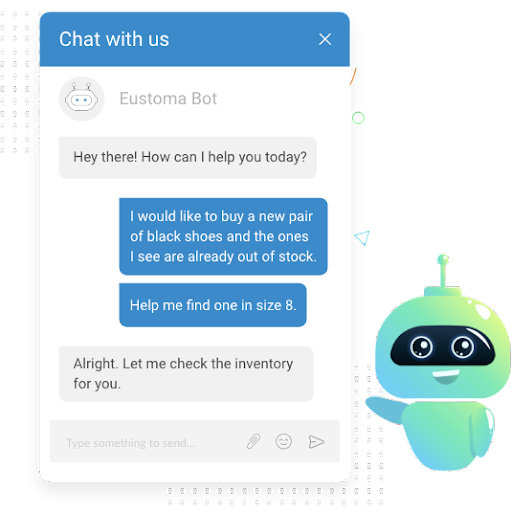
- Use AI-based chatbot to assist customers during odd hours.
- The conversational chatbot can also redirect visitors to relevant product pages, create support tickets and transfer the chat to an agent if needed.
Related Read: Best Live Chat Software Solutions To Consider In 2022
7. Use Customer Intent Software
Machines are evolving. And before they rise against humanity, you can leverage AI to understand user intent and behavior.
Dedicated AI-based customer intent data software can automatically track user behavior based on numerous inbuilt intent-based signals to find the right time to engage them.
For example, tracking the customer journey to show personalized recommendations based on the pages they visit and links they click.
These tools also offer 3rd party integrations to trigger automatic actions for improved intent-based targeting.
For example:
- Integrate it with a CRM like BIGContacts to automatically add new leads to your CRM, schedule a meeting, and add new notes to existing pipelines.
- Use the survey tool at your disposal to show feedback form and collect experience and behavioral data to understand customers’ intent.
- Send personalized notifications and discount pop-ups to users when they type a related query in the website’s search bar.
And all this happens in real-time, eliminating manual work.
These tools also come with inbuilt advanced analytics to distinguish between visitor types with high and low purchase intent.
It’s like having a personal assistant that comes with all the elements needed to do real-time customer intent modeling on your website.
But this does not subdue the importance of other intent mapping techniques like competition analysis, keyword research, and feedback analysis. They are essential to bringing more website visitors so the intent data tool can do its work.
FREE. All Features. FOREVER!
Try our Forever FREE account with all premium features!
Ready to Understand Customer Intent?
Customers are looking for a frictionless experience, whether online or in-store. Each interaction and click defines who a person is and what they are looking for. Understanding the user intent can help you forecast the next steps in the customer’s journey and take the necessary actions to target them. It can be a product inquiry, service call, complaint, or any other purpose in mind.
And you can be there early to fulfill their needs and desires.
So try out some of the practices we’ve discussed here and monitor how it fares for your business. You can then make minor tweaks to improve intent-based targeting to improve content quality and leads.
FREE. All Features. FOREVER!
Try our Forever FREE account with all premium features!



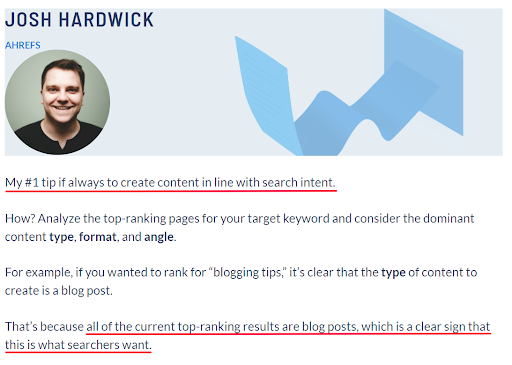


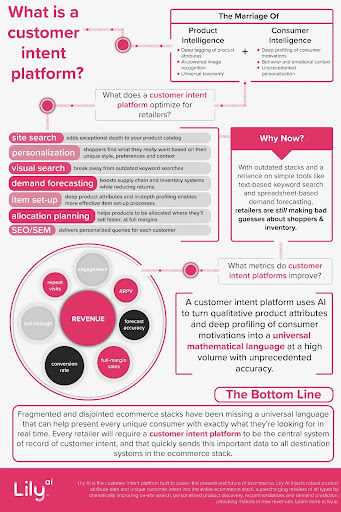

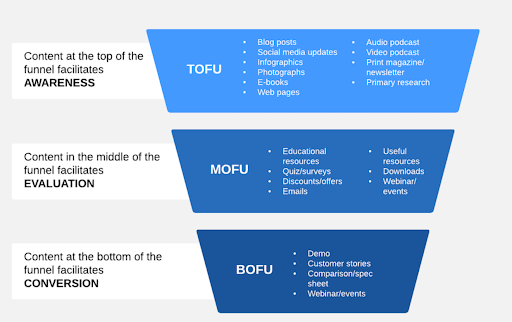
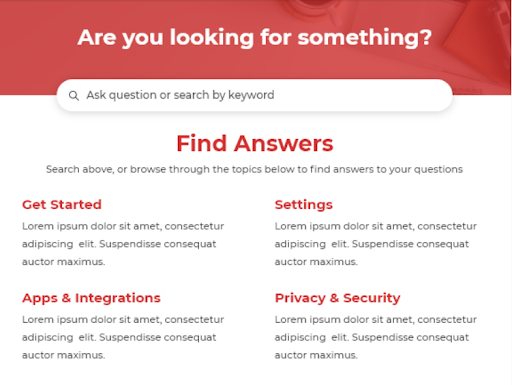

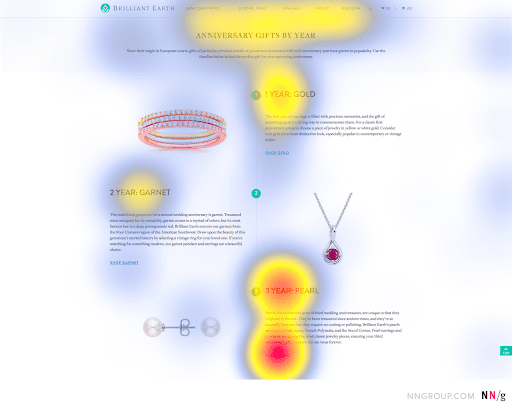
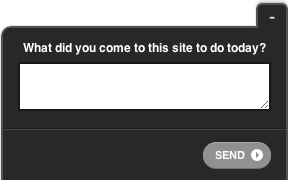
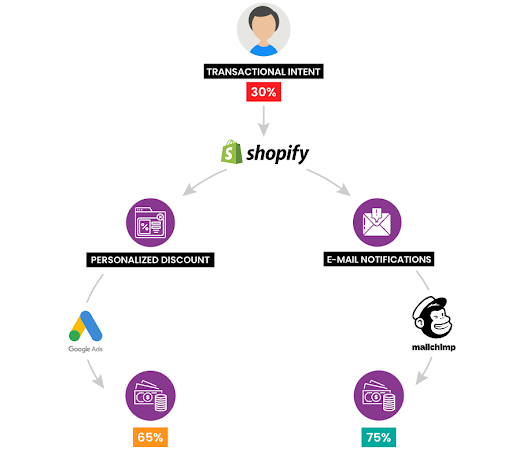
 We'd love your feedback!
We'd love your feedback! Thanks for your feedback!
Thanks for your feedback!


